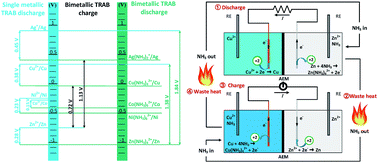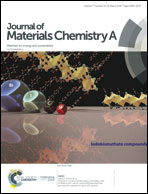A bimetallic thermally regenerative ammonia-based battery for high power density and efficiently harvesting low-grade thermal energy†
Abstract
A bimetallic thermally regenerative ammonia-based battery (B-TRAB) using inexpensive materials efficiently converts low-grade thermal energy into electricity with high power density. Through thermal regeneration of the anolyte, the B-TRAB system realized high-voltage discharge (1.38 V) with redox couples [Cu(II)/Cu and Zn(NH3)42+/Zn] and low-voltage charge (0.72 V) with Zn(II)/Zn and Cu(NH3)42+/Cu. Adding 2 M NH3 to the anolyte of a Cu/Zn-TRAB produced a peak discharge power density of 525 W m−2-electrode (120 W m−2-membrane), and the voltage (or current) and peak power could be doubled by connecting two cells in series (or parallel). In successive regeneration cycles, a maximum power density of 115 W m−2-electrode (26 W m−2-membrane) and a net energy density of 714 W h m−3 were produced at a constant current density of 100 A m−2. The power density was enhanced to 515 W m−2-electrode (118 W m−2-membrane) and maintained in successive cycles by adding acid to the regenerated catholytes, with a net energy density of 299 W h m−3 (discharged at a constant load of 12 Ω and charged at a constant current density of 100 A m−2). A thermal-electricity conversion efficiency of 0.95% (10.7% relative to the Carnot efficiency) was achieved.



 Please wait while we load your content...
Please wait while we load your content...